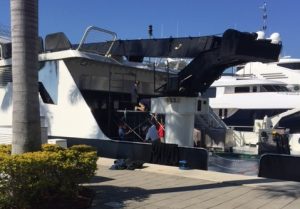
The captain of a 215’ Expedition recently contracted our hydraulics team at High Seas Hydraulics to work on the vessel’s crane. This particular yacht is a shadow boat hired out to “shadow” luxury yachts ferrying extra crews and other “toys” the luxury yacht owners or guest may need on their extended voyages. Those toys can range from large tenders to cars to even a helicopter.
The two luffing cylinders on the crane were leaking hydraulic fluids at the seals and needed resealing before the vessel went out to sea again. The catch on this job was the size of the crane, the weight of the cylinders and the timeline to fix. We had just one week to pull, diagnose, fix and re-install the luffing cylinders on this 26 ton crane, the largest crane we have worked on at High Seas Hydraulics. Each luffing cylinder weighs over a ton and needs special equipment to handle.
Coordination was key to ensure this job went smoothly. We first had to rent scaffolding that needed to be erected on the aft deck in order  for our hydraulic technicians to reach and secure the cylinders for removal from the boat. We then rented a boom truck with a 73 foot reach from a local business to remove the luffing cylinders from the yacht and place on our sister company, Straight Line Marine’s flatbed truck for transportation back to the shop. Having a flatbed truck as part of our fleet comes in handy for these types of jobs as well as moving large shafts from mega yachts.
for our hydraulic technicians to reach and secure the cylinders for removal from the boat. We then rented a boom truck with a 73 foot reach from a local business to remove the luffing cylinders from the yacht and place on our sister company, Straight Line Marine’s flatbed truck for transportation back to the shop. Having a flatbed truck as part of our fleet comes in handy for these types of jobs as well as moving large shafts from mega yachts.
Once back in the shop, we inspected the luffing cylinders and sent them out to be resealed. The company that we contracted to reseal the luffing cylinders was unable to pressure test the luffing cylinders due to equipment problems so they were returned to High Seas Hydraulics. Fortunately, we have the proper equipment and experienced technicians to perform the testing in house for these cylinders that required 2,500 pounds of pressure.
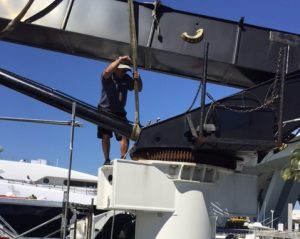
Communications is key
Upon completion of the service work and testing, we returned the luffing cylinders to the yacht using our flatbed, brought the rental boom truck back and re-erected the scaffolding. Here is where the real precision work comes into play. While the boom truck does the heavy lifting, our hydraulic technicians guide the cylinders into place using safety line, straps and chain come-along ratchets. Communications with the crane operator is crucial and is most often done with hand signals.
We first secured the lower end of the cylinders into the crane and pinned them into place while they were still  attached to the boom truck crane. Installing the pin on a crane of this size takes balance and a little brute force! Once in place, we released the straps from the boom truck crane and using straps and the chain come-along ratchets, raised the luffing cylinders into place for securing the top to the crane. We then reattached the hydraulic hoses to the yacht’s crane so we could use the boat’s hydraulic power to extend the luffing
attached to the boom truck crane. Installing the pin on a crane of this size takes balance and a little brute force! Once in place, we released the straps from the boom truck crane and using straps and the chain come-along ratchets, raised the luffing cylinders into place for securing the top to the crane. We then reattached the hydraulic hoses to the yacht’s crane so we could use the boat’s hydraulic power to extend the luffing 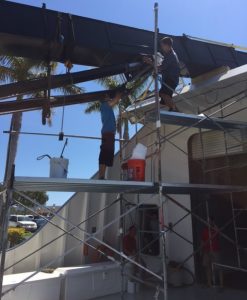 cylinders for the final pin installation. While this work takes experience and knowledge of the process, performing the task while standing on scaffolding more than 10 feet of the deck adds to the complexity.
cylinders for the final pin installation. While this work takes experience and knowledge of the process, performing the task while standing on scaffolding more than 10 feet of the deck adds to the complexity.
Once the luffing cylinders were firmly and securely in place, we re-installed the rest of the hydraulic hoses and tested the crane to ensure that it was working properly for the demanding tasks it undertakes while at sea.
This was a big job with a tight timeline that we were able to push through so the captain could meet his charter schedule. This shadow boat is ready to set sail with those “little extras” that help to make memorable adventures.





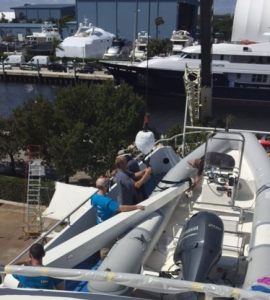
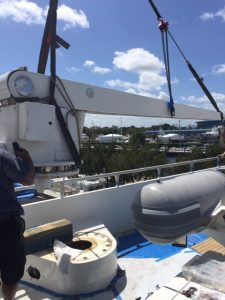 adjust the straps in order to control the unit as it was lifted into the air. Cranes have a very uneven weight distribution and weigh several hundred pounds so without the proper balance applied by the straps and chain come-along, they could twist or slip potentially hitting the deck or the side of the yacht while being lowered to the ground.
adjust the straps in order to control the unit as it was lifted into the air. Cranes have a very uneven weight distribution and weigh several hundred pounds so without the proper balance applied by the straps and chain come-along, they could twist or slip potentially hitting the deck or the side of the yacht while being lowered to the ground.